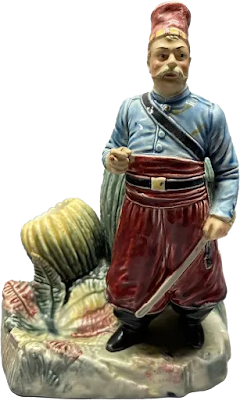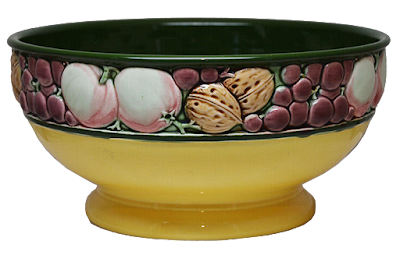Bernard Bloch was born in Mecov, Austria in 1836. Raised in a family of German Jews, he had elementary formal religious training in a Jewish school. Rather than seek higher education, he began work at a shipping company in the Karlovey Vary region of Bohemia delivering clay to potteries for porcelain manufacture, a prevalent industry in the area. Through this connection he developed an education in pottery manufacturing which created an interest in entering the field. When a pottery in Uncin—then a city in Austria—came up for sale in 1869, he purchased it and entered the trade under the name of B. Bloch & Co.
The company made a wide variety of items from decorative art pottery to siderolith to majolica to table and sanitary wares. Smoking associated pieces though, became what they were best known for. In 1895 Bloch expanded his business by purchasing a pottery in Eichwald, Bohemia—present day Dubi, Czechoslovakia—and added tile and stove manufacturing to his line of ceramics. Bloch successfully ran the company there for the next fourteen years until his death in 1909.
After Bloch’s death, the company continued operation during the first World War in the production of majolica and art pottery under the Eichwald name, eventually incorporating in 1920 under the name of Eichwald Porcelain and Stove Company Bernard Bloch & Co., now part of Czechoslovakia. The pottery continued the manufacture of majolica long after most potteries had stopped making the ware.
Until 1940 the pottery continued successful operation when, during the Nazi occupation, the Jewish owned company was seized from the Bloch family and given to the German Dr. H. Widera & Co. and renamed Eichwald Porcelain, Stove, and Tile Factory Dr. Widera & Co.
Two years after the fall of Nazi Germany, the company was nationalized in 1947 under the Czech Republic and merged with Royal Dux and Count Thun’s Porcelain Factory into Duchcov Porcelain. They continued using the Eichwald name on some of their wares.
It’s debatable whether the pottery made after the World Wars should be considered majolica as we know it. It certainly isn’t Victorian majolica. It has a very different look from Victorian majolica, often using opaque glazes in addition to the more traditional clear glazes. Additionally it has more modern designs than what we are used to seeing with Victorian majolica. The pottery continued manufacture of this hybrid ware well into the late 1950s.
In 1957 Ducov merged with Carlsbad Porcelain which continues business today.
Throughout its existence Bloch/Eichwald also made some beautiful utilitarian and decorative pieces in porcelain, earthenware siderolith and terracotta decorated in matte glazes and enamels. These aren’t majolica and shouldn't be confused with it though it is frequently marketed as such. One clue in identifying it is when the body is visible where the enamel has worn through.










































































very informative
ReplyDelete